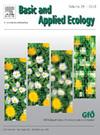德国多种草地植物种子转移带遗传多样性评价
IF 3.5
2区 环境科学与生态学
Q2 ECOLOGY
引用次数: 0
摘要
物种多样性和种内遗传多样性在草地生态系统的保护和恢复中起着至关重要的作用。为了保持本地野生植物的区域适应性,用于恢复项目的种子是在区域生产的。区域的划分由种子转移区(STZs)组织。一些欧洲国家已经建立了统一适用于许多物种的广义stz。理想情况下,广义的stz应该基于大量物种的种内遗传和表型多样性的综合数据。然而,缺少这样的基础数据。RegioDiv项目旨在填补这一空白,并生成德国多种草原植物物种遗传变异的经验数据。在这里,我们描述了项目的驱动原则和主要方法。在22个现有的stz中,以平均1个样本/1000 km2的密度共采集了33个物种,共11976个样本用SNP标记进行了基因分型。遗传群体结构分析包括聚类分析、距离隔离分析和环境隔离分析。对一种广泛分布的禾草——毛缕草(Agrostis capillaris)的种内遗传簇进行了典型的种内分析,发现了5个种内遗传簇,它们分布在空间上一致的范围内,但与stz不完全匹配。大多数stz的遗传差异遵循距离隔离和环境隔离的模式。在跨种分析中,遗传分化受交配制度和倍性的影响。异交和多倍体的分化程度低于自交和二倍体。然而,禾本科和中草药之间的遗传分化没有显著差异,突出了这些类群内物种之间的差异。RegioDiv项目的数据集将促进草原植物物种遗传变异的基础研究和应用研究。结果将允许评估当前的德国STZ系统并指导潜在的改进。本文章由计算机程序翻译,如有差异,请以英文原文为准。
Assessment of genetic diversity among seed transfer zones for multiple grassland plant species across Germany
Species diversity and intraspecific genetic diversity play a critical role in conservation and restoration of grassland ecosystems. To maintain regional adaptations of native wild plants, seeds for restoration projects are produced regionally. The delineation of regions is organised by seed transfer zones (STZs). Generalised STZs that apply uniformly to many species have been established in several European countries. Ideally, generalised STZs should be based on comprehensive data of intraspecific genetic and phenotypic diversity for a larger number of species. However, such underlying data is missing. The project RegioDiv aims to fill this gap and generate empirical data on genetic variation of multiple grassland plant species across Germany. Here we describe the driving principles and main methods of the project. A total of 33 species were collected at an average density of ∼1 sample/1000 km2 across the 22 existing STZs, and a total of 11,976 samples were genotyped with SNP markers. The analysis of genetic population structure included cluster analysis and analyses of isolation-by-distance and isolation-by-environment. An exemplary within-species analysis for Agrostis capillaris, a widespread grass, revealed five intraspecific genetic clusters, distributed in spatially coherent ranges that did not fully match the STZs. Most of the STZs differed genetically following a pattern of isolation-by-distance and isolation-by-environment. In an across-species analysis, genetic differentiation was affected by mating system and ploidy. Outcrossed and polyploid species were less differentiated than self-compatible and diploid species. However, genetic differentiation did not significantly differ between grasses and herbs, highlighting the variability among species within these groups. The dataset of the RegioDiv project will advance both basic and applied research on genetic variation of grassland plant species. The results will allow the assessment of the current German STZ system and guide potential improvements.
求助全文
通过发布文献求助,成功后即可免费获取论文全文。
去求助
来源期刊

Basic and Applied Ecology
环境科学-生态学
CiteScore
6.90
自引率
5.30%
发文量
103
审稿时长
10.6 weeks
期刊介绍:
Basic and Applied Ecology provides a forum in which significant advances and ideas can be rapidly communicated to a wide audience. Basic and Applied Ecology publishes original contributions, perspectives and reviews from all areas of basic and applied ecology. Ecologists from all countries are invited to publish ecological research of international interest in its pages. There is no bias with regard to taxon or geographical area.
 求助内容:
求助内容: 应助结果提醒方式:
应助结果提醒方式:


